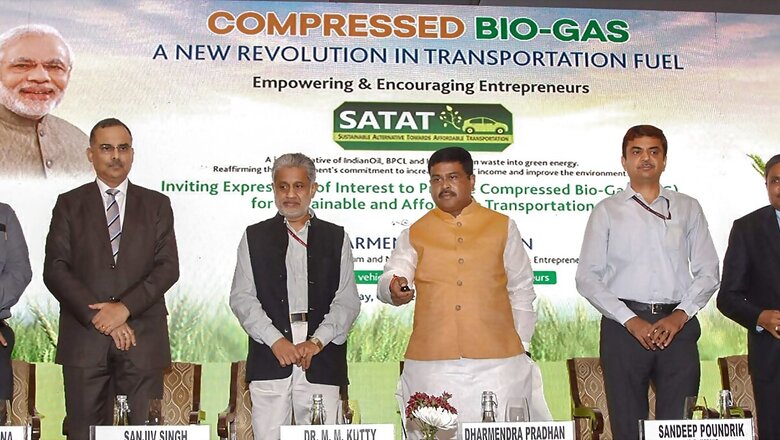
views
Launched in October 2018 by the Ministry of Petroleum and Natural Gas, the Sustainable Alternative Towards Affordable Transportation (SATAT) initiative marked a pivotal moment in India’s pursuit of green energy solutions. The initiative aimed to establish a network of Compressed Bio-Gas (CBG) production plants, producing cleaner fuel from organic waste sources and contributing to a more sustainable transportation sector.
As SATAT completes six years, it is an opportune time to reflect on its progress, impact, and the role it has played in shaping India’s green fuel landscape.
Early Progress and Milestones
The initial years of SATAT were marked by a surge of enthusiasm from both entrepreneurs and investors, eager to tap into the potential of the nascent CBG sector. This resulted in the issuance of 4,090 Letters of Intent (LoIs) for the establishment of CBG plants, indicating a strong interest in establishing production facilities across the country. By June 2022, 35 CBG plants were successfully commissioned and were operational, producing compressed biogas and contributing to the diversification of India’s energy mix.
These initial successes, however, represented a small fraction of the overall target of 5,000 plants envisioned by 2023-24, highlighting the challenges in translating initial interest into tangible outcomes.
Despite falling short of the initial target, the Standing Committee on Petroleum and Natural Gas, responsible for overseeing the implementation of SATAT, recognised the importance of the initiative in achieving a more sustainable energy future for India. The committee viewed SATAT as a crucial step towards establishing domestic production of natural gas, thereby reducing the nation’s reliance on imported fossil fuels.
This approach aligned with the broader national objectives of energy security, reduced carbon emissions, and the promotion of a circular economy by utilising organic waste as a valuable resource. Moreover, the committee highlighted the potential for job creation and economic development in rural areas, as CBG plants could be established closer to the sources of feedstock, such as agricultural farms and livestock operations.
Impact on Environment and Contribution to SDGs
A core objective of the SATAT initiative lies in minimising India’s reliance on imported fossil fuels and subsequently reducing the environmental impact associated with their extraction, processing, and combustion. Compressed Bio-Gas (CBG), derived from organic waste and boasting a methane content exceeding 95 per cent, presents a cleaner alternative to conventional fossil fuels. By utilising agricultural residues, cattle dung, and municipal solid waste as feedstock for CBG production, the initiative promotes responsible waste management practices. This, in turn, helps curb carbon emissions that would otherwise arise from the decomposition of these materials in landfills or through open burning. A study conducted by the Indian Institute of Technology, Guwahati, revealed that India possesses the capacity to produce 80,000 metric tonnes of compressed biogas daily. This quantity of CBG has the potential to replace 50 per cent of the diesel currently used in transportation, significantly reducing the nation’s carbon footprint.
Furthermore, the SATAT initiative aligns seamlessly with India’s broader aspirations in the realm of sustainable development and its commitment to achieving net-zero carbon emissions by 2070. By promoting the use of CBG across various sectors, including transportation, the initiative contributes to a flat out reduction in greenhouse gas emissions. Beyond its direct impact on carbon emissions, SATAT also supports sustainable agricultural practices through the production of bio-fertilisers, such as Fermented Organic Manure (FoM), as a by-product of CBG production.
By fostering a circular economy approach, where organic waste is transformed into valuable resources, SATAT contributes to multiple Sustainable Development Goals (SDGs), including SDG 7 (Affordable and Clean Energy), SDG 12 (Responsible Consumption and Production), and SDG 13 (Climate Action).
Success Stories and Entrepreneurial Spirit
The SATAT initiative has created a fertile ground for entrepreneurs to establish themselves as key players in India’s burgeoning green fuel sector. Individuals like Gaurav Kedia, Chairman of the Indian Biogas Association, have emerged as leaders, spearheading the establishment of large-scale CBG plants and actively promoting the wider adoption of biogas technology. They have demonstrated the commercial viability of CBG production and have played a crucial role in raising awareness about its benefits as a sustainable and environmentally friendly fuel source. Their efforts have helped overcome initial scepticism and demonstrate the feasibility of integrating biogas into India’s energy landscape.
The growth of the biogas industry, spurred by initiatives like SATAT, has also had a positive impact on employment generation. According to the International Renewable Energy Agency (IRENA), the biogas industry in India created an estimated 85,000 jobs in 2022. This job creation spans various aspects of the biogas value chain, from the collection and processing of feedstock to the operation and maintenance of CBG plants and the distribution and marketing of CBG as a fuel.
Furthermore, the establishment of CBG plants in rural areas has the potential to provide employment opportunities to local communities, contributing to rural economic development and reducing the migration of workers to urban centres in search of employment. But a lot more remains to be done.
Challenges and Future Outlook
While SATAT has made significant strides in its first six years, it also faces challenges that need to be addressed to realise its full potential. These include streamlining the supply chain of feedstock, ensuring the availability of financing for CBG projects, and developing robust market mechanisms for CBG and its by-products. The Standing Committee on Petroleum and Natural Gas has made several recommendations to address these challenges, including the reintroduction of a Central Financial Assistance scheme for CBG projects, providing generation-based incentives, and establishing a single-window clearance mechanism for approvals.
The SATAT initiative stands as a significant landmark in India’s ongoing transition towards a more sustainable energy landscape. While the journey over the past six years has not been without its challenges, the progress made thus far speaks volumes about the viability of CBG as a cleaner and readily available fuel alternative. The initiative has showcased the potential for CBG to be integrated into India’s energy mix, paving the way for a future where transportation and other sectors can rely less on imported fossil fuels.
Moving forward, addressing the existing challenges and implementing the insightful recommendations proposed by various stakeholders will be key to unlocking the full potential of SATAT. Ensuring access to financing for CBG projects will be one of the major challenges, but it will also ensure the acceleration in its adaptation. This, in turn, will contribute significantly to achieving our green energy targets, reducing the dependence on imported fossil fuels, and fostering a cleaner and healthier environment for generations to come.
















Comments
0 comment